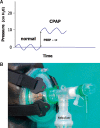Indications and practical approach to non-invasive ventilation in acute heart failure
- PMID: 29186485
- PMCID: PMC6251669
- DOI: 10.1093/eurheartj/ehx580
Indications and practical approach to non-invasive ventilation in acute heart failure
Abstract
In acute heart failure (AHF) syndromes significant respiratory failure (RF) is essentially seen in patients with acute cardiogenic pulmonary oedema (ACPE) or cardiogenic shock (CS). Non-invasive ventilation (NIV), the application of positive intrathoracic pressure through an interface, has shown to be useful in the treatment of moderate to severe RF in several scenarios. There are two main modalities of NIV: continuous positive airway pressure (CPAP) and pressure support ventilation (NIPSV) with positive end expiratory pressure. Appropriate equipment and experience is needed for NIPSV, whereas CPAP may be administered without a ventilator, not requiring special training. Both modalities have shown to be effective in ACPE, by a reduction of respiratory distress and the endotracheal intubation rate compared to conventional oxygen therapy, but the impact on mortality is less conclusive. Non-invasive ventilation is also indicated in patients with AHF associated to pulmonary disease and may be considered, after haemodynamic stabilization, in some patients with CS. There are no differences in the outcomes in the studies comparing both techniques, but CPAP is a simpler technique that may be preferred in low-equipped areas like the pre-hospital setting, while NIPSV may be preferable in patients with significant hypercapnia. The new modality 'high-flow nasal cannula' seems promising in cases of AHF with less severe RF. The correct selection of patients and interfaces, early application of the technique, the achievement of a good synchrony between patients and the ventilator avoiding excessive leakage, close monitoring, proactive management, and in some cases mild sedation, may warrant the success of the technique.
Keywords: Acute cardiogenic pulmonary oedema; Acute heart failure; Bilevel pressure support; CPAP; High-flow nasal cannula; Non-invasive ventilation.
Published on behalf of the European Society of Cardiology. All rights reserved. © The Author 2017. For permissions, please email: journals.permissions@oup.com.
Figures






Comment in
-
Chronisches respiratorisches Versagen, Weaning.Med Klin Intensivmed Notfmed. 2019 Mar;114(2):96-97. doi: 10.1007/s00063-018-0525-8. Med Klin Intensivmed Notfmed. 2019. PMID: 30847530 German. No abstract available.
References
-
- Girou E, Brun-Buisson C, Taillé S, Lemaire F, Brochard L.. Secular trends in nosocomial infections and mortality associated with noninvasive ventilation in patients with exacerbation of COPD and pulmonary edema. JAMA 2003;290:2985–2991. - PubMed
-
- Dickstein K, Cohen-Solal A, Filippatos G, McMurray JJV, Ponikowski P, Poole-Wilson PA, Stromberg A, van Veldhuisen DJ, Atar D, Hoes AW, Keren A, Mebazaa A, Nieminen M, Priori SG, Swedberg K, Vahanian A, Camm J, De Caterina R, Dean V, Dickstein K, Filippatos G, Funck-Brentano C, Hellemans I, Kristensen SD, McGregor K, Sechtem U, Silber S, Tendera M, Widimsky P, Zamorano JL, Tendera M, Auricchio A, Bax J, Bohm M, Corra U, della Bella P, Elliott PM, Follath F, Gheorghiade M, Hasin Y, Hernborg A, Jaarsma T, Komajda M, Kornowski R, Piepoli M, Prendergast B, Tavazzi L, Vachiery J-L, Verheugt FWA, Zamorano JL, Zannad F; ESC Committee for Practice Guidelines (CPG) . ESC guidelines for the diagnosis and treatment of acute and chronic heart failure 2008: the task force for the diagnosis and treatment of acute and chronic heart failure 2008 of the European Society of Cardiology. Eur Heart J 2008;29:2388–2442. - PubMed
-
- Mebazaa A, Pang PS, Tavares M, Collins SP, Storrow AB, Laribi S, Andre S, Mark Courtney D, Hasa J, Spinar J, Masip J, Frank Peacock W, Sliwa K, Gayat E, Filippatos G, Cleland JG, Gheorghiade M.. The impact of early standard therapy on dyspnoea in patients with acute heart failure: the URGENT-dyspnoea study. Eur Heart J 2010;31:832–841. - PubMed
-
- Park JJ, Choi DJ, Yoon CH, Oh IY, Lee JH, Ahn S, Yoo BS, Kang SM, Kim JJ, Baek SH, Cho MC, Jeon ES, Chae SC, Ryu KH, Oh BH; KorHF Registry. The prognostic value of arterial blood gas analysis in high-risk acute heart failure patients: an analysis of the Korean Heart Failure (KorHF) registry. Eur J Heart Fail 2015;17:601–611. - PubMed
-
- Nieminen MS, Böhm M, Cowie MR, Drexler H, Filippatos GS, Jondeau G, Hasin Y, Lopez-Sendon J, Mebazaa A, Metra M, Rhodes A, Swedberg K, Priori SG, Garcia MA, Blanc JJ, Budaj A, Cowie MR, Dean V, Deckers J, Burgos EF, Lekakis J, Lindahl B, Mazzotta G, Morais J, Oto A, Smiseth OA, Garcia MA, Dickstein K, Albuquerque A, Conthe P, Crespo-Leiro M, Ferrari R, Follath F, Gavazzi A, Janssens U, Komajda M, Morais J, Moreno R, Singer M, Singh S, Tendera M, Thygesen K; ESC Committe for Practice Guideline (CPG). Executive summary of the guidelines on the diagnosis and treatment of acute heart failure. The task force on acute heart failure of the European Society of Cardiology endorsed by the European Society of Intensive Care Medicine (ESICM). Eur Heart J 2005;26:384–416. - PubMed
Publication types
MeSH terms
Grants and funding
LinkOut - more resources
Full Text Sources
Other Literature Sources
Medical

